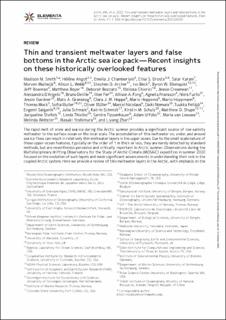| dc.contributor.author | Smith, Madison M. | |
| dc.contributor.author | Muilwijk, Morven | |
| dc.contributor.author | Chierici, Melissa | |
| dc.contributor.author | Fer, Ilker | |
| dc.contributor.author | Fransson, Agneta | |
| dc.contributor.author | Gardner, Jessie | |
| dc.contributor.author | Granskog, Mats | |
| dc.contributor.author | Müller, Oliver | |
| dc.contributor.author | Salganik, Evgenii | |
| dc.date.accessioned | 2023-12-07T14:15:02Z | |
| dc.date.available | 2023-12-07T14:15:02Z | |
| dc.date.created | 2023-10-03T15:21:53Z | |
| dc.date.issued | 2023 | |
| dc.identifier.citation | Elementa: Science of the Anthropocene. 2023, 11 (1), . | |
| dc.identifier.issn | 2325-1026 | |
| dc.identifier.uri | https://hdl.handle.net/11250/3106471 | |
| dc.description.abstract | The rapid melt of snow and sea ice during the Arctic summer provides a significant source of low-salinity meltwater to the surface ocean on the local scale. The accumulation of this meltwater on, under, and around sea ice floes can result in relatively thin meltwater layers in the upper ocean. Due to the small-scale nature of these upper-ocean features, typically on the order of 1 m thick or less, they are rarely detected by standard methods, but are nevertheless pervasive and critically important in Arctic summer. Observations during the Multidisciplinary drifting Observatory for the Study of Arctic Climate (MOSAiC) expedition in summer 2020 focused on the evolution of such layers and made significant advancements in understanding their role in the coupled Arctic system. Here we provide a review of thin meltwater layers in the Arctic, with emphasis on the new findings from MOSAiC. Both prior and recent observational datasets indicate an intermittent yet long-lasting (weeks to months) meltwater layer in the upper ocean on the order of 0.1 m to 1.0 m in thickness, with a large spatial range. The presence of meltwater layers impacts the physical system by reducing bottom ice melt and allowing new ice formation via false bottom growth. Collectively, the meltwater layer and false bottoms reduce atmosphere-ocean exchanges of momentum, energy, and material. The impacts on the coupled Arctic system are far-reaching, including acting as a barrier for nutrient and gas exchange and impacting ecosystem diversity and productivity. | |
| dc.language.iso | eng | |
| dc.subject | Polarforskning | |
| dc.subject | Polar research | |
| dc.subject | Polaroseanografi | |
| dc.subject | Polar oceanography | |
| dc.subject | Lagdeling | |
| dc.subject | Stratification | |
| dc.subject | Sjøis | |
| dc.subject | Sea ice | |
| dc.subject | Arktisk is | |
| dc.subject | Arctic ice | |
| dc.subject | Polhavet | |
| dc.subject | Arctic ocean | |
| dc.title | Thin and transient meltwater layers and false bottoms in the Arctic sea ice pack-Recent insights on these historically overlooked features | |
| dc.title.alternative | Thin and transient meltwater layers and false bottoms in the Arctic sea ice pack-Recent insights on these historically overlooked features | |
| dc.type | Peer reviewed | |
| dc.type | Journal article | |
| dc.description.version | publishedVersion | |
| dc.subject.nsi | VDP::Oseanografi: 452 | |
| dc.subject.nsi | VDP::Oceanography: 452 | |
| dc.subject.nsi | VDP::Oseanografi: 452 | |
| dc.subject.nsi | VDP::Oceanography: 452 | |
| dc.source.pagenumber | 41 | |
| dc.source.volume | 11 | |
| dc.source.journal | Elementa: Science of the Anthropocene | |
| dc.source.issue | 1 | |
| dc.identifier.doi | 10.1525/elementa.2023.00025 | |
| dc.identifier.cristin | 2181394 | |
| cristin.ispublished | true | |
| cristin.fulltext | original | |
| cristin.qualitycode | 1 | |
